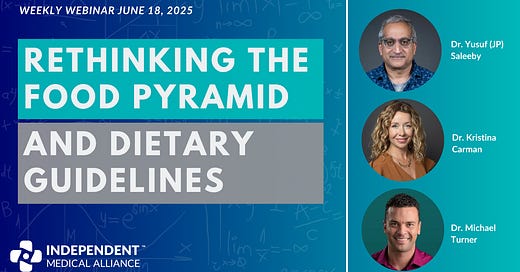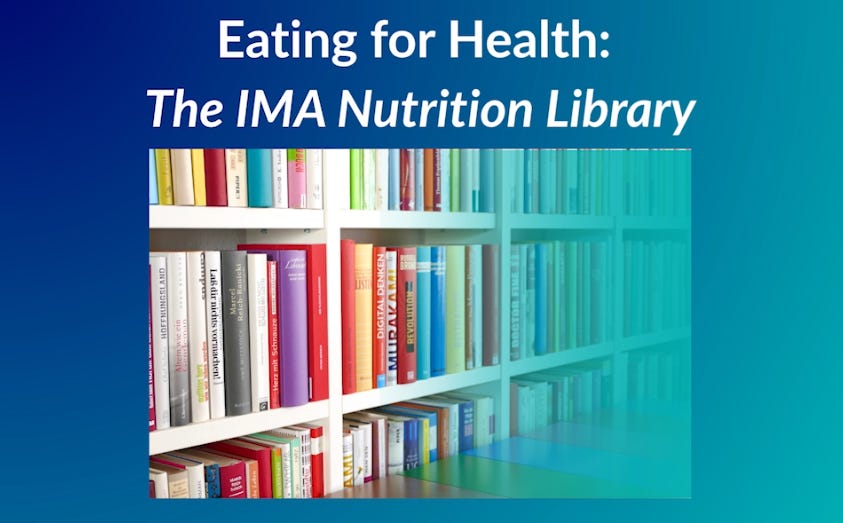Speakers: Dr. Yusuf (JP) Saleeby, Dr. Kristina Carman, Dr. Michael Turner
Webinar Slides: Download
IMA Senior Fellows Dr. Yusuf (JP) Saleeby, Dr. Kristina Carman, and Dr. Michael Turner unpack the problems with the Food Pyramid (and its modern cousin, MyPlate). They explore the history of flawed nutritional advice, the industry influence behind government food policy, and how these guidelines have contributed to today’s chronic disease epidemic.
We’ve all seen it: that colorful food pyramid plastered across classroom walls, doctors’ offices, and cafeteria posters for decades. Now transformed into “MyPlate,” these official dietary guidelines promise balanced nutrition and a blueprint for health. But what happens when the blueprint itself is flawed?
Despite decades of government nutritional advice, Americans are sicker than ever. Chronic diseases like obesity, diabetes, heart disease, and autoimmune disorders are skyrocketing, even among children. Clearly, something isn’t working.
In this webinar, Senior Fellows Dr. J.P. Saleeby, Dr. Kristina Carman, and Dr. Michael Turner explored precisely why our official dietary guidelines have missed the mark. They uncovered where these recommendations went wrong, how agribusiness interests distorted nutritional science, and most importantly, what we can do about it.
You can watch the full webinar by clicking play above, or read on below for an actionable summary of what the experts discussed.
1. What’s Wrong with the Official Dietary Guidelines?
Since their introduction in the 1980s, official dietary guidelines—reflected by the outdated food pyramid and now by MyPlate—have frequently missed the mark. According to Dr. Saleeby, these recommendations often prioritize the interests of agribusiness rather than public health.
“You kind of wonder, is this for the betterment of the public, or is it another way for agribusiness propaganda to be put forth on the scene?”
Indeed, these guidelines disproportionately emphasize grains, underrepresent critical protein sources, and fail to distinguish between whole and processed foods. They lump sugary fruit juices in with fresh fruits, undervalue the role of healthy fats, and virtually ignore the essential role of dietary fiber.
2. Do “Recommended Daily Allowances” Fall Short?
One major shortcoming of current guidelines is reliance on Recommended Daily Allowances (RDAs), which merely prevent overt deficiency diseases like scurvy or rickets. Dr. Kristina Carman points out that today’s health challenges demand far more nuanced nutritional guidance.
“We really need to look at optimal daily intake versus what is recommended… our lifestyles are different, our level of stress is different, we need to revisit these numbers because we are living very different lives now”
Optimal Daily Intake (ODI) targets health and longevity, not just survival. For instance, vitamin D and magnesium, critical for immune function, bone health, and mood regulation, require doses significantly higher than the outdated RDA. The gap between minimal and optimal nutrient intake underscores why many people remain chronically unhealthy, despite technically “adequate” nutrition.
Dr. Carman shared the following slides, which demonstrates how far off the current RDAs are from her perspective as a nutrition expert:
3. Addressing the Processed Food Problem
Ultra-processed foods dominate modern diets, hiding in plain sight as convenient, cheap, and heavily marketed options. In the webinar, Dr. Carman explained there are layers upon layers of issues with processed foods.
For example, the high heat required to process low-cost vegetable oils result in oxidized fats and other inflammatory byproducts. Dr. Saleeby reminds us that processed foods also contain unhealthy additives, and certain foods can even be susceptible to mold contamination.
Seed oils, refined sugars, and artificial additives flood grocery shelves. These ingredients promote inflammation, disrupt gut health, and contribute directly to chronic diseases like obesity, diabetes, and heart disease. The solution lies in returning to minimally processed, whole-food ingredients, emphasizing simplicity and transparency in what we eat.
👉 Learn more: What’s Really in Your Food? A Guide to Food Additives
4. The Power of Protein
Despite widespread protein availability, many Americans remain protein-deficient, especially older adults and those at risk for osteoporosis. Dr. Michael Turner emphasizes the vital role protein plays beyond muscle maintenance:
“Protein supports muscle mass, strength, and even bone health—bones are structurally about 50% protein… Most people are quite below optimal intake and feel better when they perk their protein status up.”
Dr. Turner recommends aiming for approximately 1.2 grams of protein per kilogram of body weight daily, increasing that number further for active individuals, the elderly, or those at risk of bone loss. Incorporating ample protein through whole foods—such as eggs, chicken, beans, and nuts—dramatically improves health outcomes.
👉 Learn more: Protein Sources Guide: Tips for Protein Optimization
5. Sodium Myths and Realities
Another misconception embedded in current dietary recommendations involves sodium intake. Though the sodium debate continues, Dr. Saleeby notes that guidelines often oversimplify the narrative, failing to account for individual sensitivities and the differences between natural salts and heavily refined table salt.
“Not everyone is sensitive to sodium chloride as far as hypertension goes. Current guidelines oversimplify a complex nutritional issue.” —Dr. J.P. Saleeby
Instead of blanket restrictions, we should focus on choosing minimally processed salts like Himalayan or Celtic sea salt, providing additional minerals without the harmful additives found in refined table salts.
👉 Learn more: What’s Missing From Your Water? A Guide to Electrolytes
More IMA Resources
This webinar was jam-packed with expert insights, but this hour-long discussion was only one piece of a much larger puzzle. Over the years, IMA has created and curated dozens of nutrition-centric resources.
Most of these resources can be found filed under “Nutrition“ in our tools and guides section. For those looking for more, step into our new nutrition library! There you’ll find even more nutrition resources, more webinars, more guides, and more ways to eat your way to better health.
All of these resources—from our webinars and guides to extensive nutrition libraries—are made possible by the generous support of our donors. If you value this work and believe in making reliable, practical health information accessible to everyone, please consider making a donation.
Final Thoughts
Until we can rely on the dietary guidelines our health agencies provide, we’ll benefit greatly from the expert advice of nutritionally minded doctors like the ones on this panel. Improving dietary habits needn’t be overwhelming. Dr. Turner reminds us to start small and celebrate each positive change:
“Just pick one thing, even if it’s drinking more water, or not eating after 8 p.m., or avoiding processed foods… just pick one thing to focus on like a lazer beam and celebrate your victories.”
Ultimately, moving toward healthier eating habits is about shifting away from nutritional dogma toward sustainable, enjoyable, and individualized practices. Real nourishment isn’t rigid—it’s flexible, balanced, and bountiful.



















Share this post